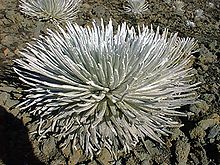- Deserts and xeric shrublands
-
"Xeric" redirects here. For the comic book grant foundation, see Xeric Foundation.
Deserts and xeric shrublands is a biome characterized by, relating to, or requiring only a small amount of moisture.[1]
Contents
Definition and occurrence
Deserts and xeric shrublands receive an annual average rainfall of ten inches or less, and have an arid or hyperarid climate, characterized by a strong moisture deficit, where annual potential loss of moisture from evapotranspiration well exceeds the moisture received as rainfall. Deserts and xeric shrublands occur in tropical, subtropical, and temperate climate regions. Desert soils tend to be sandy or rocky, and low in organic materials. Saline or alkaline soils are common. Plants and animals in deserts and xeric shrublands are adapted to low moisture conditions. Hyperarid regions are mostly devoid of vegetation and animal life, and include rocky deserts and sand dunes. Vegetation in arid climate regions can include sparse grasslands, shrublands, and woodlands. Plants adapted to arid climates are called xerophytes, and include succulent plants, geophytes, sclerophyll, and annual plants. Animals, including insects, reptiles, arachnids, birds and mammals, are frequently nocturnal to avoid moisture loss.
Desertification
The conversion of productive drylands to desert conditions is known as desertification, and can occur from a variety of causes. One factor is human intervention in imposing intensive agricultural tillage or overgrazing[2] in areas which cannot support such exploitation. Climatic shifts such as global warming or the Milankovitch cycle (which drives glacials and interglacials) also affect the pattern of deserts on Earth.
See also
Desert and xeric shrublands ecoregions
Afrotropic Deserts and xeric shrublandsSeychelles Arabian Peninsula coastal fog desert Oman, Saudi Arabia, Yemen East Saharan montane xeric woodlands Chad, Sudan Eritrean coastal desert Djibouti, Eritrea Ethiopian xeric grasslands and shrublands Djibouti, Eritrea, Ethiopia, Somalia, Sudan Gulf of Oman desert and semi-desert Oman, United Arab Emirates Hobyo grasslands and shrublands Somalia Ile Europa and Bassas da India xeric scrub Bassas da India, Europa Kalahari xeric savanna Botswana, Namibia, South Africa Kaokoveld desert Angola, Namibia Madagascar spiny thickets Madagascar Madagascar succulent woodlands Madagascar Masai xeric grasslands and shrublands Ethiopia, Kenya Nama Karoo Namibia, South Africa Namib desert Namibia Namibian savanna woodlands Namibia Red Sea coastal desert Egypt, Sudan Socotra Island xeric shrublands Yemen Somali montane xeric woodlands Somalia Southwestern Arabian foothills savanna Oman, Saudi Arabia, Yemen Southwestern Arabian montane woodlands Saudi Arabia, Yemen Succulent Karoo South Africa Australasia Deserts and xeric shrublandsCarnarvon xeric shrublands Australia Central Ranges xeric scrub Australia Gibson Desert Australia Great Sandy-Tanami Desert Australia Great Victoria Desert Australia Nullarbor Plain xeric shrublands Australia Pilbara shrublands Australia Simpson Desert Australia Tirari-Sturt's Stony Desert Australia Western Australian mulga shrublands Australia Indus Valley desert India, Pakistan Northwestern thorn scrub forests India, Pakistan Thar desert India, Pakistan Nearctic Deserts and xeric shrublandsMexico Central Mexican matorral Mexico Chihuahuan desert Mexico, United States Colorado Plateau shrublands United States Great Basin shrub steppe United States Gulf of California xeric scrub Mexico Meseta Central matorral Mexico Mojave desert United States Okanagan (South) shrub steppe Canada Snake-Columbia shrub steppe United States Sonoran desert Mexico, United States Tamaulipan matorral Mexico Tamaulipan mezquital Mexico Wyoming Basin shrub steppe United States Neotropic Deserts and xeric shrublandsVenezuela Aruba-Curaçao-Bonaire cactus scrub Aruba, Bonaire, Curaçao Atacama desert Chile, Peru Caatinga Brazil Cayman Islands xeric scrub Cayman Islands Cuban cactus scrub Cuba Galápagos Islands xeric scrub Ecuador Guajira-Barranquilla xeric scrub Colombia, Venezuela La Costa xeric shrublands Venezuela Leeward Islands xeric scrub Anguilla, Antigua and Barbuda, British Virgin Islands, Guadeloupe, Saint Martin, Saint Barthélemy, Saba, US Virgin Islands Malpelo Island xeric scrub Colombia Motagua Valley thornscrub Guatemala Paraguana xeric scrub Venezuela San Lucan xeric scrub Mexico Sechura desert Peru Tehuacán Valley matorral Mexico Windward Islands xeric scrub Barbados, Dominica, Grenada, Martinique, Saint Lucia, Saint Vincent and the Grenadines Saint Peter and Saint Paul rocks Brazil - this is because it gets only ten inches of precipitation a year
Biomes and Ecozones Terrestrial
biomesPolar/montaneTemperate(Sub)tropicalDryMediterranean forests, woodlands, and scrub · Deserts and xeric shrublandsWetAquatic
biomesOther biomes Ecozones References
- ^ Merriam-Webster.com Merriam-Webster Dictionary definition of xeric
- ^ C.Michael Hogan. 2009. Overgrazing. Encyclopedia of Earth. Sidney Draggan, topic ed.; Cutler J. Cleveland, ed., National council for Science and the Environment, Washington DC
External links
- Deserts and xeric shrublands (World Wildlife Fund)
- Map of the ecozones
- Index to Deserts & Xeric Shrublands at bioimages.vanderbilt.edu
- Xeric World Online Community focused on the study of Xeric Plant Species.
Categories:- Deserts and xeric shrublands
- Terrestrial biomes
- Flora of the California desert regions
- North American desert flora
Wikimedia Foundation. 2010.

